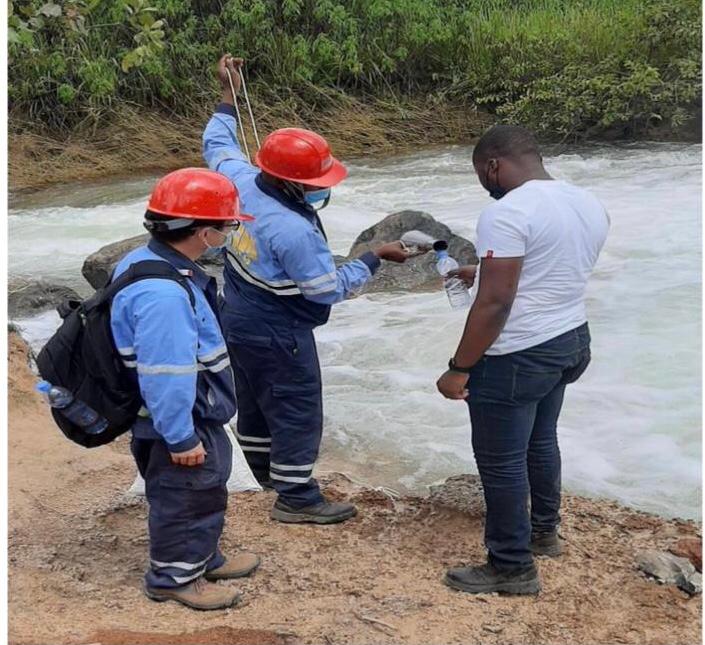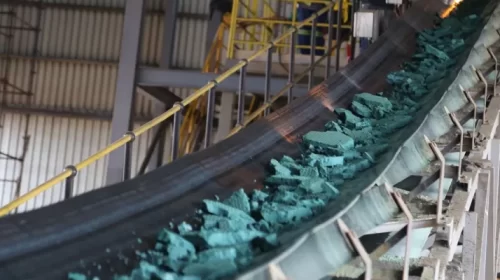Water pollution in Yenge and Kapanga villages in the DRC: Sicomines SA cleared of accusations
The Provincial Division of Mines has once again cleared the Sino-Congolaise des Mines (SICOMINES SA) of the accusations and campaigns of bad faith orchestrated against it for some time in social networks and the media by certain organizations, in particular the NGO African Resources Watch ( AFREWATCH).
According to a publication dated March 24, 2022 on the social networks of the African Natural Resources Observatory (AFREWATCH), an NGO for the promotion and protection of human rights working in the natural resources sector, demonstrating a certain mining company carrying out work to mitigate a large influx of wastewater by irrigating a rubble and gravel dam alongside a blue wire mesh fence, SICOMINES was once again cited.
Said publication (a press release) reveals that one of the basins containing acid waste from the mining company SICOMINES had given way on Tuesday, March 22 around 11 a.m., letting the toxic liquid content flow into the Kalemba river, causing the passage of serious new impacts among the communities of Yenge and Kapanga villages including flooding of dwelling houses, vegetable gardens, fish ponds, water wells.
SICOMINES has not remained silent in the face of these accusations and has, on each occasion, wanted to prove and demonstrate concretely, to be an ideal partner that promotes green development in the DRC in environmental protection, using quality materials of the latest generation. This joint venture has become, for some time, the target of detractors wanting to damage its image. From the poor treatment of its agents to the pollution of the environment, the SCM has been picked up in all directions, without wavering.

SICOMINES denies all the accusations made against it, as set out in the press release published by the NGO AFREWATCH, which charges it with organizing the dumping of industrial wastewater on the fields and homes of Yenge and Kapanga.
To this end, a mission carried out by the Department of Protection of the Mining Environment (DPEM) has, following an investigation, noted several findings, including in particular a significant influx of water escaping from another mining concession. other than Sicomines, contrary to the revelations in the AFREWATCH press release.
The Mining Environmental Protection Department (DPEM) organized an investigation upstream and downstream of the Kalemba River, with the aim of shedding light on a press release and images on social networks, published by this NGO.
A group of experts from the DPEM has, for this purpose, carefully examined the images and videos published by Afrewatch upstream, and carried out a descent on the ground with a view to feeling with the finger and establishing a possible causal link between the concession of Sicomines and this spill on the Kalemba River.
According to the DPEM report, the results of these surveys revealed that the images as described in the press release from the NGO AFREWATCH do not reflect the realities on the ground.
To this end, several findings were revealed by the DPEM according to which Sicomines is neither involved in this dumping of industrial wastewater on the Kalemba River, nor in the negative impacts on the fields and homes of the villages of Yenge and Kapanga, such as alleged in a press release, videos and images published by the NGO Afrewatch made public last month through social networks.
Investigations carried out on site by the DPME also indicated that there is no evidence of massive flow of water or chemicals upstream or downstream of the Sicomines in the Kalemba River.
However, underlines the DPME report, Sicomines has a disposal basin made up of waste from the extraction process. Thereupon, the outpouring waters of the Sicomines which escape are channeled through specific channels to be immersed in the initial recycling circuit.
The DPME also points out that the water collected by the drain of the secondary basin is redirected to a station equipped with 4 submerged pumps which return the water to the ore processing plant and/or to the discharge basin according to the needs in water supply.
The water retention basin of the company SICOMINES SA, is a basin which collects all the water that comes from the company’s installations. It is important because the capture of runoff water, seepage water and stagnant water in the concession to be recycled and sent back to the mineral processing plant.
At the level of the upper Kalemba dike, which constitutes the point downstream of the flow of wastewater from the company SICOMINES SA, KCC and the former dike of GECAMINES SA “Poto Poto”, the latter is located 1500 meters in downstream of the concession of the company SICOMINES SA, after taking samples behind and in front of the bridge connecting the road leading to the village of Yenge, once again no sign of accidental spillage of factory water.
The DPEM also underlined the importance attributed by the company SICOMINES SA in the environmental management of its concession, which makes available colossal material and financial resources for the maintenance of these two waste basins with an obvious technology for its mining.
On this, Sicomines deplores the distortion of information made by several NGOs in order to tarnish its image both nationally and internationally. It also recalls its commitment to support the DRC in its development as well as to promote respect for human life in the protection of the environment.
![]()





